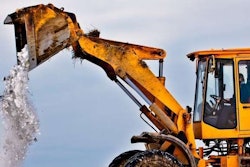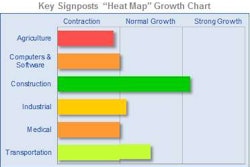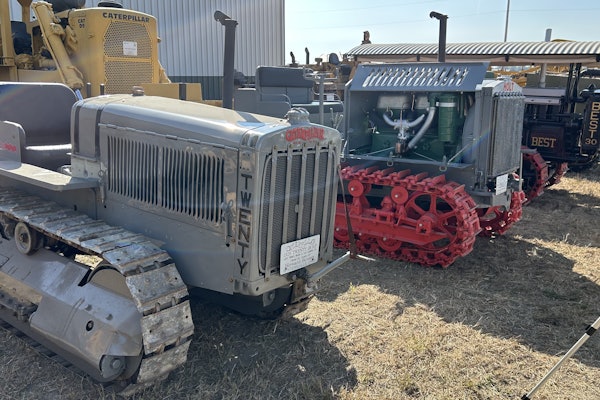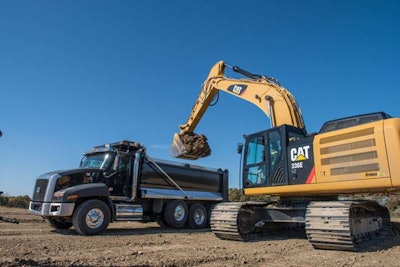 Caterpillar’s innovative new 336E H hybrid excavator
Caterpillar’s innovative new 336E H hybrid excavatorFuel, fuel, fuel.
That’s the common thread running through each of our four Equipment World Innovations Awards this year.
Three of our winners help you do more work using less fuel. With fears of a coming “Tier 5” regulation cutting the amount of carbon you can put in the air, these three manufacturers have come up with new and ingenious ways to boost the efficiency of their machines.
• Caterpillar’s 336E H excavator uses a hydraulic hybrid system to “conserve, optimize and reuse” the maximum amount of energy created by the engine, with efficiencies as high as 50 percent.
• Caterpillar’s 966K XE wheel loader tackles the same goals with a split-power, continuously variable transmission that can coax up to 25 percent improvement in fuel efficiency.
• Volvo’s On Board Weighing system for articulated trucks senses load weight to within 1 percent, helping operators and fleet managers prevent over or under-loading and thus save on fuel, tires and engine life.
• JCB’s Ecomax engines solve a different, but equally challenging fuel problem: what to do with an engine built for ultra low sulfur diesel, if and when it’s sold or shipped to a country with higher sulfur levels.
Congratulations to these manufacturers for their contributions to bettering the environment and helping solve some of their customers and our readers, most pressing problems.
Volvo’s On Board Weighing System
Sensors and telematics bring precision to mass excavation
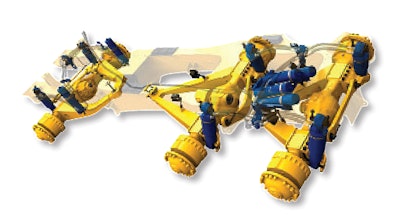
Until, that is, Volvo Construction Equipment came up with their On Board Weighing System (OBW). Developed by a team of Volvo engineers with the goal of improving articulated hauler productivity, the OBW uses sensors to measure gas pressure in the A35FFS and A40FFS artics with full suspension gas accumulators. Signals from the sensors are relayed to software integrated into the machine’s electronics and can tell the operator if he is under or over loaded, or getting stuck with carryback.
And the OBW can calculate a truck’s load accurate to 1 percent.
“Before this system there was a huge difference in the loads articulated haulers would carry,” says Mikael Petersson, technical product manager at Volvo CE. The OBW helps prevent overload and the resulting machine wear, tire damage and excess fuel consumption that go with it. It also helps prevent the machine from being operated with a reduced load ensuring maximum productivity and efficiency, he says.
Operators running a Volvo artic with the OBW will see a yellow light when the truck is at partial load, green at nominal load and red when overloaded. The light is also visible to the loader operator. The information is routed to Volvo’s CareTrack telematics system enabling supervisors, fleet managers and others to remotely access production and performance data. This includes total transported load in tons, tons per gallon of fuel, number of cycles and machine overloads. When compiled over time, the information can monitor operator performance and provide daily, weekly or monthly productivity reports to help managers track progress and develop more accurate estimates for the next project.
Why we like this product
Telematics is a great technology that’s having a hard time gaining a foothold in the construction industry. It’s kind of like having a smart phone with limited apps.
With the Volvo On Board Weighing system, contractors now have a powerful app with an immediate payback and benefit that goes beyond the location-hours-fuel data that ordinary telematics offers. Now you can measure work directly and instantaneously and that’s going to prove to be a big benefit for those who use it.
– Tom Jackson | [email protected]
A recalibration opens up the world to a Tier 4 Interim engine
JCB says it had an advantage when it developed its first Ecomax engines launched in 2004: the expected Tier 4 Final emissions regulations were already understood. “We had the benefit of a clean sheet of paper design,” says Alan Tolley, director, engine programs. “That allowed us to factor in lower particulate levels early.”
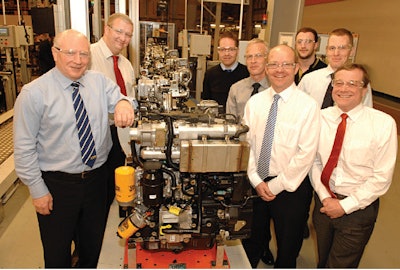 The design team
The design teamresponsible
for the Ecomax Tier 4 Interim engine included from left Alan Tolley, director of engine programs; Nick Pease, homologation manager; Kevin Browne, principal design engineer;
Alasdair Duncan,
project manager; Paul McCarthy, manager, calibration and controls; Lee Stafford, Tier 4 champion;
Matthew Niven, engine development manager; and Bob Womersley, chief engineer.
But when JCB started its Tier 4 Interim development in 2007, addressing concerns over the need to use ultra low sulfur diesel (ULSD) “was not a major part of the program, as the introduction of Tier 4 was predicated on the availability of ULSD,” Tolley says. The question soon percolated up from the company’s customers, however: How would they be able to sell a Tier 4 machine around the world, where many areas have high fuel sulfur levels? (See sidebar next page.)
While JCB announced it would not use a DPF in its Tier 4 Interim engines in 2010, ULSD requirements were not a key driver in the decision. Instead, the company ticked off a list of perceived DPF negatives: their size makes them difficult to tuck under the hood, especially in compact machines. They have to be regenerated. “DPFs can make fuel consumption worse since they put back pressure on the engine, making it less efficient,” Tolley says. The company chose to reach emission goals by using in-cylinder technologies.
No DPF, no ULSD
It became apparent in not using a DPF, JCB could also address the ULSD question. DPFs require the use of ULSD since the filters are easily poisoned by sulfur. “You really don’t need to use ULSD if you don’t have a DPF, so the Ecomax works quite happily without low sulfur fuel,” Tolley says. Choosing to opt out of using a DPF also allowed JCB to avoid DPF’s low-ash oil requirement.
But that wasn’t the entire answer to the eventual resale problem. “We had to consider the wider range of other fuel characteristics found in non-emissionised markets, and ensure the engine would handle these” Tolley says. This required a recalibration of the engine control module (ECM) that would a.) close the EGR valve so exhaust gas wasn’t returned to the engine, and b.) lower injection pressure to reduce the strain on the injection equipment.
Changing codes
As envisioned, the recalibration process would go like this: A U.S. machine owner planning to export a machine to a lower regulated country would send it to a JCB dealer. The dealer registers the machine and engine serial numbers and then receives recalibration approval from JCB. Using JCB’s diagnostic Service Master Tool, the dealer enters the recalibration codes and attaches a label to the engine saying it no longer meets U.S. emission requirements. The serial numbers of machines would be made available to the authorities. “It’s basically just a case of reprogramming the ECM,” Tolley says. The process is still undergoing EPA approval.
 JCB has added the
JCB has added theEcomax engine to its
line of telehandlers,
backhoes and skid steers.
JCB wants to make one thing crystal clear: this recalibration is for the export markets only, designed to help the resale value of used machines. “There’s absolutely no advantage with the recalibration in terms of fuel consumption or performance,” Tolley says. “And it’s still a relatively low emissions engine even after the recalibration, with NOx and PM emissions around Tier 3 levels. It’s just better able to handle the poor-quality fuels you find around the world.”
It’s a Tier 4 Interim solution, however. Meeting the tighter Tier 4 Final requirements in 2014 will likely require “some sort of NOx-reducing aftertreatment,” Tolley says. The company expects to make its Tier 4 Final announcement this spring and will offer a kit for Tier 4 Final for export to lower regulated countries.
The ULSD problem
Most Tier 4 Interim-compliant machines require ULSD since sulfur clogs their DPFs. Down the road, that presents no problem in the resale market as long as the used Tier 4 Interim machine is bought by a buyer from a highly regulated area, such as the United States and Europe. The states have already converted to ULSD, which has a sulfur level of 15 parts per million or lower. The DPFs in these machines, however, would choke on the fuel in Mexico – which has fuel with 50 to 500 parts per million sulfur – without some type of “de-tiering” solution. The same situation is true with much of the world, which has varying levels of sulfur in its fuel, leaving questions about the resale value of Tier 4 Interim machines if they can no longer be sold in these markets.
For a quick picture of world fuel sulfur levels, go to unep.org/transport/pcfv.
Why we like this product
In not using a DPF in their Tier 4 Interim product – the only engine manufacturer to accomplish this in the 74 to 174 horsepower range – JCB was able to address the ULSD concern that’s becoming more recognized in highly regulated countries such as the United States. That’s good news for buyers who, a few years from now, want the entire global market open to their used machines.
– Marcia Gruver Doyle | [email protected]
Two machines, two paths to fuel efficiency
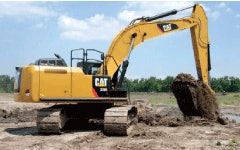
• A hydraulic hybrid system on its 336E H excavator
• An integrated power train with a split-power transmission on its 966K XE wheel loader.
336E H excavator
 The Electronic Standardized Programmable (ESP) pump transitions between power sources to conserve fuel.
The Electronic Standardized Programmable (ESP) pump transitions between power sources to conserve fuel.When Cat unveiled the 336E H to the press in October, two announcements got immediate attention: one, the use of a hydraulic hybrid system instead of electric, and two, a 25-percent reduction in fuel consumption compared to the current 336E. When placed side by side with the previous generation 336D, the hybrid’s fuel reduction goes up to 33 percent. Considering all factors, Cat says the total fuel efficiency of the hybrid could be as high as 50 percent, measured in tons per liter, compared to the D Series machine.
Cat took a dual path approach in exploring hybrid options: one engineering team looked at electric hybrids and another examined hydraulics. Randy Peterson, with the Advanced Component and Systems division at Caterpillar, hesitates to use the term “competing” when talking about the teams. “Both were working toward a common goal,” he says. “While the electric hybrid approach worked well, it was still difficult to meet all cost goals for this size of machine. There was a clear winner between the cost of the two systems.” (Cat does, however, use electric hybrid technology on its 6120B H FS mining shovel.)
Conserve, optimize and reuse
From the outside, the hybrid machine looks just like the current 336E, but there are significant changes under the hood. Caterpillar promotes “conserve, optimize, and reuse” terminology when explaining the hybrid system, with each term showcasing a key component:
Conserve: The Electronic Standardized Programmable (ESP) pump is designed to ensure smooth transition between power sources to conserve fuel. It uses a solenoid-operated proportional control valve to control the pump displacement via the engine’s electronic control module. The ESP pump enables a reduction in engine speed, allowing fuel savings and quieter operation by matching engine and pump load. Cat applied an in-house-developed algorithm to the ESP pump controls to ensure smooth transition between the hydraulic hybrid power sources, engine and accumulator (see “reuse” below). “We can seamlessly transfer between one or the other power source, and the operator doesn’t feel it,” says Aleksandar M. Egelja, engineering manager, Advanced Component and Systems division.
Optimize performance: The Adaptive Control System valve is “the brain of our hydraulic system,” Egelja says, directing flow from both the pump and accumulator. The valve serves as a logistics center, managing hydraulic restrictions and flows, sending energy to where it’s needed with no loss of power. This, in turn, reduces fuel consumption by reducing pressure losses within the hydraulic system.
Reuse: Energy is generated when an excavator swings and then brakes, common in load-and-dump cycles. This swing braking energy would normally go over the relief valve when the operator decelerates. Instead, Cat stores this energy in an accumulator, to be released when the machine accelerates. Until the accumulator runs out of charge it provides flow to the swing motor without the need to increase pump displacement. This produces less engine load, resulting in fuel savings. “We are more than 90 percent efficient at recovering otherwise wasted energy and reusing it,” Peterson says. One of the more than 300 patents Cat has on the 336E H is on the use of the hydraulic accumulator to store swing energy.
The hydraulics solution
It made good sense to apply this technology to a 36-ton excavator, Peterson says, because it’s a machine at home in a production environment. “They spend their time truck loading or trenching, and cycle frequently,” he comments. These machines apply hydraulics – which has the highest power density among in-use technologies – to almost every facet of operation.
The multifaceted nature of this excavator also made engineers aware of what they began to call “the three-headed monster” during the design process: how to maintain the machine’s productivity and controllability while improving its efficiency. “They can be conflicting requirements,” Peterson says. “For example, if the hydraulic pressure drops, it could negatively impact the machine’s controllability. And adding another source of power – the accumulator – complicated things more.”
Caterpillar says 98 percent of the 336E H’s components are standard. “We wanted to use as much as the base machine as possible so we could leverage the volume of parts to keep costs down,” Peterson says.
“One of our design criteria was that the payback period had to be in a reasonable amount of time,” Peterson says.
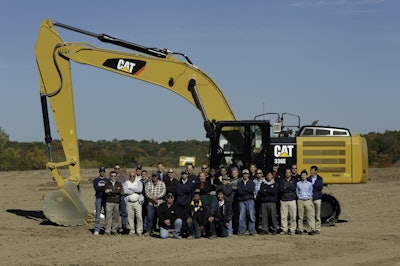 Teamwork: One of several teams working on the 336 E H project, taken at Cat’s Peoria proving grounds.
Teamwork: One of several teams working on the 336 E H project, taken at Cat’s Peoria proving grounds.So what is Cat’s definition of “reasonable time?” It depends upon the application and price of fuel, Peterson says, but should be within two years for most customers. That payback time could even be reduced to one year in high production applications.
Cat will begin delivering the machine in February, and says it expects customers will eventually select the hybrid over standard models. While there will be future models with hybrid versions, Cat is presently mum about how many and in what sizes.
966K XE
While there were definite fuel efficiency goals for the 299-net-horsepower 966K XE, “that’s not all we were after,” says Bryan Vogt, Caterpillar’s performance and controls engineering manager, medium wheel loaders. “We also wanted to optimize the performance, improve operator comfort, and create a simpler operator interface.”
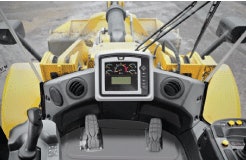 The advanced powertrain allowed Cat to eliminate one pedal from the cab, with the left pedal serving as a modulated brake.
The advanced powertrain allowed Cat to eliminate one pedal from the cab, with the left pedal serving as a modulated brake.But first things first. Depending on a customer’s application, Cat says the machine delivers up to a 25 percent improvement in fuel efficiency. The higher the job demands on the machine, the higher the potential savings. (The “XE” acts as market differentiator, to distinguish this machine from the standard 966K.)
Split-power demands
This is accomplished by what Cat calls an advanced powertrain, which makes use of a split-power continuously variable transmission concept seen in agricultural machines, but that is “vastly different” in the 966K XE, says Mike Spielman, Caterpillar’s continuously variable transmission technical team lead, medium wheel loaders. “A midsize wheel loader frequently cycles, changes directions and penetrates into piles – in short, it’s a much more demanding application than seen in agriculture. It was a challenge to develop a solution that saves fuel but doesn’t sacrifice productivity.”
In the 966K XE transmission, power is transmitted through two paths, one mechanical and the other hydrostatic, which uses a hydraulic pump and motor (or variator). The two paths provide power to the planetary gears, and since the hydraulic path can be variably controlled, so can the transmission. The approach also makes use of the high efficiency of the parallel direct-drive mechanical path. (Cat declined to go into further details of the transmission’s design.)
“We had experimented with hydraulic parallel path transmission many years ago,” says Tony Marcott, continuously variable transmission engineering manager, drivetrain systems. “We reviewed the lessons learned and determined that response, shift quality and overall controllability were key.”
Since the hydraulic variator allows the Cat C9.3 ACERT engine to run in a more efficient 1,250-to-1,600 rpm operating range independent of ground machine speed, it also reduces the heat load generated by the drivetrain, especially when the machine is under heavy load. Lower heat loads mean lower fans speeds, which in turn lowers fuel consumption. Reduced engine speeds also translate into decreased noise and vibration levels. The torque converter, and its efficiency losses, has been eliminated.
In aggressive digging, Cat says the continuously variable transmission consumes roughly half the energy of a conventional transmission. The transmission also allows the machine momentum to be recovered as free energy to power implements and/or a fan.
The advanced powertrain includes standard components – hydraulic pump and motors, gears, clutches and synchronizers – and fits into the same manufacturing envelope as the standard K-series machine. Both help lower manufacturing costs “and drive reliability and durability,” Marcott says.
Integration
“The secret is how the integrated powertrain works with the machine,” Spielman says. “The key advancements have been delivered through systems integration and a power balance of engine, powertrain and implement systems to provide quick response, acceleration and power, while significantly improving fuel efficiency.”
A big challenge: “Controlling and integrating the components to behave in a way that resulted in a machine that was simple to operate for novice operators and familiar to operate for experienced operators. By keeping these two things in mind, we were able to provide a significant advancement in technology, without the need for extensive operator training,” Spielman says.
Simplified operation
The Cat design team likes to underline how the advanced powertrain has led to simplified loader operation. Instead of three pedals found in the cab of the standard 966K, the XE has two. The left pedal modulates the retarding and neutralization functions – the further you press down the more stopping action it provides. Press down slightly, and the transmission goes into neutral, progressively retarding rimpull. Press even further down and the pedal provides integrated retarding, powering hydraulic and fan pumps. Finally, fully pressing the pedal down applies the service brakes. This reduces brake wear, since brakes are only applied when the pedal is fully pressed. This, in turn, eliminates the need for an axle oil cooler.
The right accelerator pedal can be electronically set to provide the desired amount of propulsion without the need to keep the pedal depressed, useful in hauling applications. In this instance, the left pedal acts as a modulated neutralizer while maintaining propulsion once the pedal is released.
In addition, operators can balance the right and left pedal to maintain maneuverability on grade and maintain machine speed with no further pedal input. Release of the pedals on grade will not result in rollback.
“There is no need for manual shifting,” Spielman says. “The operator is free to concentrate on bucket fill and digging capability.” The integral power system control prevents over-speeding, making it “nearly impossible” to stall the engine while digging, Cat says. And there is no need to manually downshift when engaging the pile from second gear. The machine intuitively changes from roading to loading without the need of operator input.
Expansion?
Cat introduced the advanced powertrain in the 52,311-pound 966K XE because of its broad range of applications, plus its high rimpull and runout speeds, Cat says. Other machines are under investigation to follow the XE path.
Depending upon the machine application, Cat says customers should see an ROI of approximately one to three years. Production units will be available in North America the first quarter of this year.
Additional teams involved in the Caterpillar 336E H development.
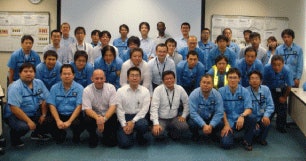 Akashi Hybrid team
Akashi Hybrid team
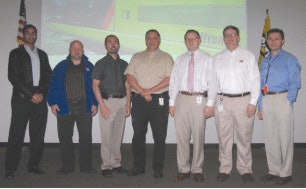 Joliet H3 team
Joliet H3 team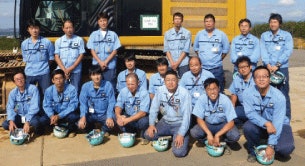 OPG Hybrid team
OPG Hybrid team





